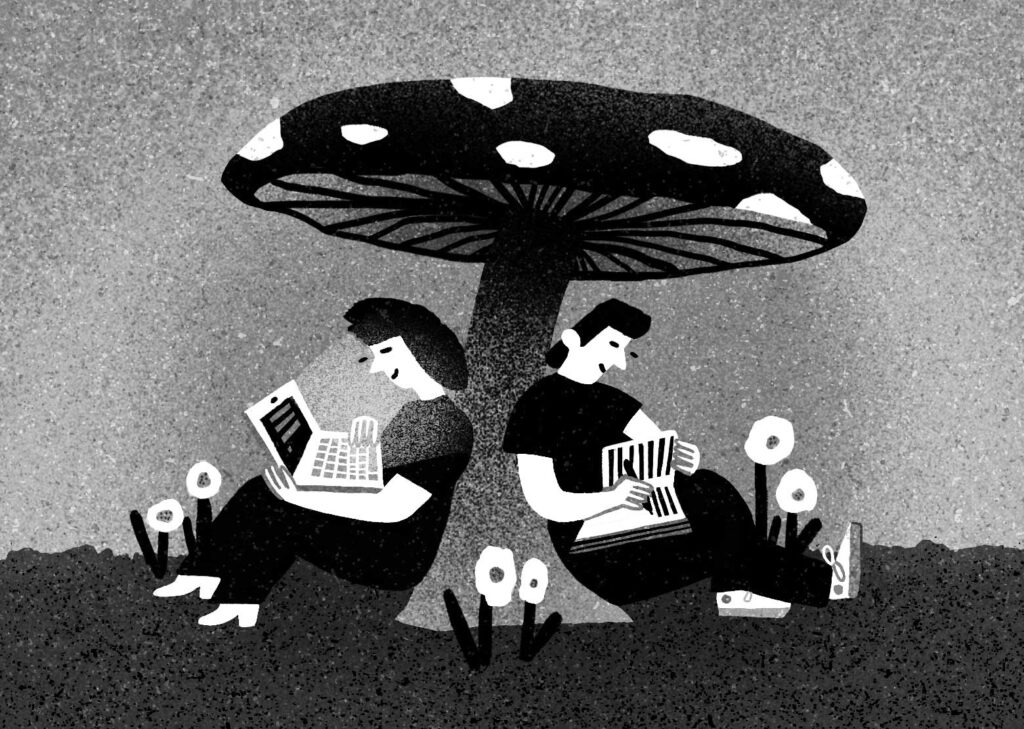There’s a cliché that the writing life is solitary, spent in a lonely garret but in contact with a higher source of inspiration. With Kilworthy Tanner, Jean Marc Ah‑Sen takes aim at this notion with the reckless abandon of a hardcore band. In chronicling the loves, estrangements, and pharmacological adventures of the “Translassitude Movement,” a fictional Toronto literary scene in the early 2000s, Ah‑Sen offers a contrasting picture of the social lives of writers and what makes them tick: frustration, lust, and revenge.
Kilworthy Tanner is the “pseudobiography” of the successful author “Kilworthy” Tanner Lepoitevin. It’s narrated by Jonno, a musician-cum-writer who has spent a few years as her collaborator and paramour. Throughout his early twenties, Jonno scrapes by, working at a guitar shop, associating with drug dealers and other ne’er‑do‑wells as he tries to get various bands off the ground. His world shifts when a friend sends him a book by Kilworthy, “a dead-eyed redhead, this little thing done up in mystic leather gear.” Reading it feels like divine intervention, but he hawks the rare edition for a month’s rent. After meeting the novelist at a reading, Jonno falls hard — for her beauty and talent, her “liberated views about moral transgressions,” and the tantalizing possibility that she’ll be involved in his literary pursuits. Shortly after he starts sleeping with Kilworthy, Jonno gets into a fight with her husband (and publicist) that leaves him unable to play guitar. He pauses his music career and begins living as a kept man in Quail Pipe, a house purchased by Kilworthy’s father.

Writing under the influence.
Sandi Falconer
So begins the literary collaboration that Ah‑Sen spends the rest of the novel unpacking. Kilworthy prefers to write under the twin influences of magic mushrooms and cocaine. Jonno, who once preferred not to work while intoxicated, slowly ratchets up his drug dependency as the two embark on a series of projects. They develop drafting practices with arcane names: “draffsacking,” where one pens the introductory and concluding sentences of paragraphs for the other to fill in later; “sillycutting,” a warm-up exercise where the pair imagine the most horrible criticisms of people they don’t care for. Manuscripts emerge from the process — some published, some not — as Jonno becomes further enmeshed in his lover’s coterie of hangers‑on. As Kilworthy’s circle grows, increasingly desperate and grasping strivers show up — characters with Pynchonian names like Gatlin “Gash” Pussmaid and Bedegraine Boisrond. Ultimately, an ill-fated reading tour stretches the limits of Jonno and Kilworthy’s relationship. The plot explodes in a riotous drama fuelled by egos, libidos, and recriminations. Characters fade and re-emerge under new identities, with new schemes and new ways to hurt one another in their scramble up the greasy pole of literary success. Artistic movements collapse just as individual bonds do — and sometimes for the same self-interested reasons. As Ah‑Sen puts it, “What business did writers have trying to foist community around a singular act of introspection and communion-taking?”
Anyone who’s read a rock ’n’ roll biography or two is likely familiar with the dynamic that Ah‑Sen explores here. Creative ambition and substance abuse are a classically combustible pairing. There are many absurd and comedic moments as Jonno gradually debases himself at the altar of Kilworthy’s aura of success. His exploits are a cornucopia of scatological, sexual, and pharmacological accidents. “Having sex with me,” he admits, “was like watching public access TV between the hours of three and six in the morning.” Ah‑Sen’s style juxtaposes these humiliations with sometimes inscrutable high-culture references. This is a world where characters venerate Old Hollywood and performance art (Otto Preminger, Ithell Colquhoun, Vito Acconci) and exclusively drink antiquated cocktails. At the same time, it is a world where one might get deliberately food-poisoned by a drug dealer’s associate at Hong Shing restaurant and where it seems like a good idea to steal parking tickets from other cars and put them on your windshield to avoid a fine of your own. This collision of the highbrow and the lowbrow is often effective. The characters’ erudition and taste are at odds with their marginalization as struggling creatives. Still, the prodigious vocabulary and references on display will send even the most logophilic reader scrambling for a dictionary.
Ah‑Sen has described Kilworthy Tanner as his “party novel.” But on top of its thrumming baseline of prurient hedonism is an exploration of whether it’s healthy, or even possible, to have a literary community. After the failed tour, Jonno writes that “collaboration was recognized in musicianship, in journalism, and in film, but it was still repellent in fiction.” For a book about writing, Kilworthy Tanner is unconcerned with moments of inspiration or even the grotty business of stacking sentences together. Prose is the heat product that arises from the friction of interpersonal entanglement.
Sometimes the plot contorts in unconvincing ways, as when characters find a new publisher by calling up someone they met at a party. Kilworthy’s half-sister appears as Jonno’s serious love interest at an all too convenient moment. Despite these weaknesses, Ah‑Sen has crafted a social novel of humour and surprising depth. If you find stories about writers insular and intolerable, this may not be for you. But if you’re intrigued by the messiness of literary creation, it’s heady, potent stuff.
Sam White is a researcher and copywriter in Toronto. He holds a master’s degree from the University of Toronto’s creative writing program.

